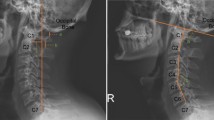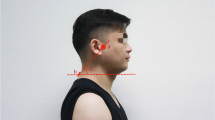Abstract
Objectives
This study aimed to assess the impact of abnormal head and neck posture on development of temporomandibular disorders (TMD) and to evaluate the possible correlation between cervical spine postural disorders and TMD by measuring craniocervical angles and distances in cervical spine radiographs of individuals with and without symptoms of temporomandibular joint dysfunction.
Methods
Forty-six subjects aged 20–50 years were selected from the outpatient department of M.S. Ramaiah Dental College and divided into TMD and control groups with 23 subjects per group. The patients were subjected to clinical and radiographic evaluations. TMD diagnosis was based on clinical criteria in the Research Diagnostic Criteria for TMD (RDC/TMD). Radiographic evaluation comprised intraobserver and interobserver analyses of lateral cervical spine radiographs with measurements of three angles and two distances in the craniocervical region.
Results
Diagnosis of myofascial pain without limited mouth opening (n = 12) was the most frequent TMD diagnosis according to RDC/TMD. Radiographic evaluation showed that only atlas plane angle (APA) (p = 0.002) and anterior translation distance (ATD; Tz C2–C7) (p < 0.001) showed significant differences between the TMD group (APA: 20.96 ± 7.94°; ATD: 11.04 ± 5.270 mm) and control group (APA: 28.17 ± 10.395°, ATD: 5.70 ± 3.535 mm). Significant correlations were observed for the parameters between the observers (p < 0.05).
Conclusions
The present results suggest that head and body posture could be related to the initial onset, development, and perpetuation of TMD and that TMD patients have a tendency to exhibit cervical spine hyperlordosis.





Similar content being viewed by others
References
McNeill C. Epidemiology. In: Rose CL, editor. Temporomandibular disorders: guidelines for classification, assessment, and management. Chicago: Quintessence; 1993. p. 19–22.
Mehta NR, Forgione AG, Rosenbaum RS, Holmberg R. “TMJ” triad of dysfunctions: a biologic basis of diagnosis and treatment. J Mass Dent Soc. 1984;33:173–6, 212–3.
Rocabado M. Analisis biomecanico craneo cervical a traves de una teleradiografia lateral. Rev Chil Ortodod. 1984;1:42–52 [In Portuguese].
Gremillion HA. The prevalence and etiology of temporomandibular disorders and orofacial pain. Tex Dent J. 2000;117:30–9.
Huggare JA, Raustia AM. Head posture and cervicovertebral and craniofacial morphology in patients with craniomandibular dysfunction. Cranio. 1992;10:173–9.
Mannheimer JS, Rosenthal RM. Acute and chronic postural abnormalities as related to craniofacial pain and temporo-mandibular disorders. Dent Clin North Am. 1991;35:185–208.
Munhoz WC, Marques AP, Siqueira TD. Radiographic evaluation of cervical spine of subjects with temporomandibular joint internal disorder. Braz Oral Res. 2004;18:283–9.
Darlow LA, Pesco J, Greenberg MS. The relationship of posture to myofascial pain dysfunction syndrome. J Am Dent Assoc. 1987;114:73–5.
Dworkin S, LeResche L. Research diagnostic criteria for temporomandibular disorders: review, criteria, examinations and specifications, critique. J Craniomandib Disord. 1992;6:301–35.
Oliveira ASD, Bravo J, Magee DJ, Thie NMR, Major PW, Flores-Mir C. The association between head and cervical posture and temporomandibular disorders. J Orofac Pain. 2006;20:9–23.
Pedroni CR, Oliveira ASD, Berzin F. Pain characteristics of temporomandibular disorder: a pilot study in patients with cervical spine dysfunction. J App Oral Sci. 2006;14:388–92.
Seligman DA, Pullinger AG. Analysis of occlusal variables, dental attrition, and age for distinguishing healthy controls from female patients with intracapsular temporomandibular disorders. J Prosthet Dent. 2000;83:76–82.
De Farias Neto JP, de Santana JM, de Santana-Filho VJ, Quintans-Junior LJ, de Lima Ferreira AP, Bonjardim LR. Radiographic measurement of the cervical spine in patients with temporomandibular dysfunction. Arch Oral Biol. 2010;55:670–8.
Broch J, Slagsvold O, Rosler M. Error in landmark identification in lateral radiographic head plates. Eur J Orthod. 1981;3:9–13.
Lee WY, Okeson JP, Lindroth J. The relationship between forward head posture and temporomandibular disorders. J Orofac Pain. 1995;9:161–7.
Sonnesen L, Bakke M, Solow B. Temporomandibular disorders in relation to craniofacial dimensions, head posture and bite force in children selected for orthodontic treatment. Eur J Orthod. 2001;23:179–92.
Visscher CM, De Boer W, Lobbezoo F, Habets LL, Naeije M. Is there a relationship between head posture and craniomandibular pain? J Oral Rehabil. 2002;29:1030–6.
Matheus RA, Ramos-Perez FMDM, Menezes AV, Ambrosano GMB, Heiter-Neto F, Boscolo FN, et al. The relationship between temporomandibular dysfunction and head and cervical posture. J App Oral Sci. 2009;17:204–8.
Acknowledgments
We would like to thank our Principal and Professor, Dr. H.N. Shama Rao, for his support and guidance.
Conflict of interest
There are no financial or other relations that could lead to a conflict of interest.
Author information
Authors and Affiliations
Corresponding author
Rights and permissions
About this article
Cite this article
Rakesh, N., Yashoda Devi, B.K., Patil, D.J. et al. Assessment of cervical spine postural disorders in patients with temporomandibular dysfunction: a radiographic evaluation. Oral Radiol 30, 38–44 (2014). https://doi.org/10.1007/s11282-013-0142-4
Received:
Accepted:
Published:
Issue Date:
DOI: https://doi.org/10.1007/s11282-013-0142-4




